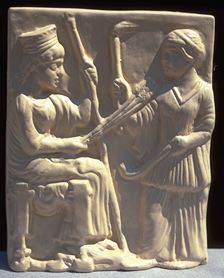 Overview
Overview
 Related Information
Related Information
 Hymns to Demeter
Hymns to Demeter
 Notes
Notes
 Shrine to Demeter
Shrine to Demeter
 Demeter from Sacred Source | The Greek earth goddess par excellence, who brings forth the fruits of the earth, particularly the various grains. She taught mankind the art of sowing and ploughing so they could end their nomadic existence. As such, Demeter was also the goddess of planned society. She was very popular with the rural population. As a fertility goddess she is sometimes identified with Rhea and Gaia. In systematized theology, Demeter is a daughter of Cronus and Rhea and sister of Zeus by whom she became the mother of Persephone. When Persephone was abducted by Hades, lord of the underworld, Demeter wondered the earth in search of her lost child. During this time the earth brought forth no grain. |
 Ceres from Sacred Source | In ancient art, Demeter was often portrayed (sitting) as a solemn woman, often wearing a wreath of braided ears of corn. Well-known is the statue made by Knidos (mid forth century BC). Her usual symbolic attributes are the fruits of the earth and the torch, the latter presumably referring to her search for Persephone. Her sacred animals were the snake (an earth-creature) and the pig (another symbol of fertility). Some of her epithets include Auxesia, Deo, Chloe, and Sito. The Romans equated her with the goddess Ceres. |
Back to the TopSong of the All-Mother
By Marian Green
I am the Mother Earth, and you're a Child to me,
Discover who you are and seek divinity.
Rocks and stones and clay and peat - all strata are a part of me,
Jewels and crystals, gems and gold are hidden in the heart of me.
Herbs and flowers, trees and shrubs, these are growing green on me,
Mosses, fungi, lichens, vines, all of these are seen on me.
Horses, cattle, pigs and deer, bears and lions roam on me,
Snakes and spiders, rats and slugs, all creatures have their home on me.
Bubbling brooks and silent springs, living rivers flow on me,
Pools and puddles, lakes and seas, salty oceans grow on me.
Tiny toddlers, mighty whales, sacred salmon leap for me,
Sharks and squid and crabs and krill fill the waters deep for me.
Wrens and larks and crows and terns fill my skies with darting flight,
Hawks and eagles, bats and owls catch their prey by day and night.
Creeping worm and flying fox, teeming ants fulfill their lives,
In tune with me, in Nature's way, as honey bees enrich my hives.
Only humans rob their kin, despoil the land, pollute the seas,
Kill for fun, destroy the woods, float poisoned vapours on the breeze.
I shall live, for I can heal, even if you humans die,
But you can learn, as Children should, to grow in peace beneath the sky.